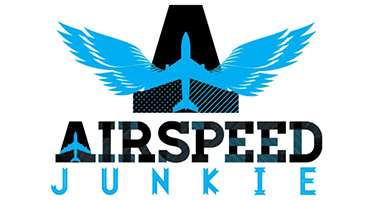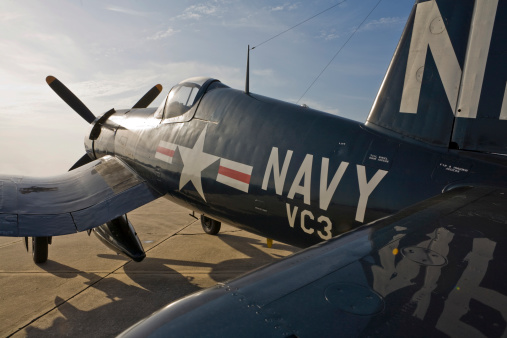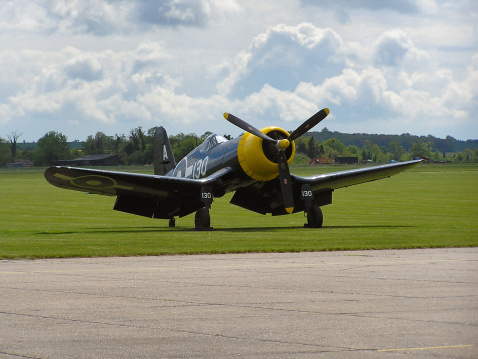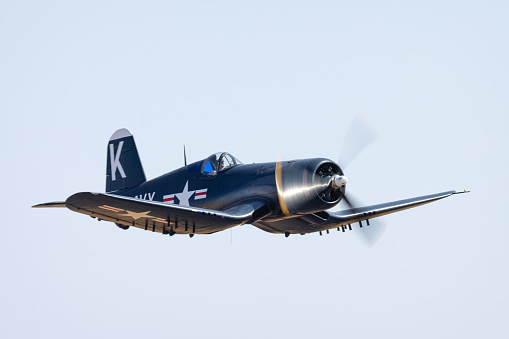F4U Corsair | All You Need To Know About Pappy Boyington's Choice of Fighters
The Vought F4U Corsair was a carrier-based fighter aircraft that saw service in World War II and the Korean War. The plane was designed and produced by Chance Vought Aircraft and had one of the longest production runs of any piston-engine fighter aircraft in history. The Chance Vought F4U is renowned for its historical significance, distinctive gull-wing design, and iconic status among military aircraft. The Corsair was designed as a carrier-based aircraft, but it proved to be so successful on land that it became one of the most widely used fighter-bombers of the war.
Demand for the aircraft soon overwhelmed Vought’s manufacturing capability, resulting in production by Goodyear and Brewster: Goodyear-built Corsairs were designated FG while those built by Brewster were designated F3A.
It is estimated that over 12,500 Corsairs were built between 1940 and 1952. Corsair production peaked during World War II, but declined after the war, with the aircraft continuing to serve in various countries' military services through the 1950s and 1960s. When corsairs arrived at key bases such as Tacloban and Samar in the Philippines, they were immediately involved in combat operations, supporting air battles and ground missions during the Philippine campaign. Today, the airplane is highly revered by aviation enthusiasts and warbird collectors alike. In this blog post, we’ll take a deep dive into the history and design of this iconic American fighter plane.
Introduction to the Vought F4U Corsair
The Vought F4U Corsair stands as one of the most iconic fighter aircraft of World War II and the Korean War, renowned for its distinctive gull wing design and formidable performance. Developed by Chance Vought, the F4U Corsair was engineered as a carrier-based fighter, intended to give the U.S. Navy and Marine Corps a decisive edge in aerial combat. Powered by the robust Pratt & Whitney R-2800 Double Wasp engine, the Corsair boasted a top speed exceeding 400 mph, making it one of the fastest piston-engine fighters of its era. Its agility and firepower allowed Corsair pilots to dominate enemy aircraft, achieving an impressive 11:1 kill ratio in the Pacific War. The combination of innovative engineering and combat effectiveness cemented the Vought F4U Corsair’s reputation as a game-changer in both carrier operations and land-based missions, earning the respect of both allies and adversaries.
Development
In 1938, The U.S. Navy Bureau of Aeronautics requested a single-engine fighter to call for a maximum obtainable speed and a stalling speed no higher than 70 miles per hour. The fighter also had to carry four guns or three with increased ammunition. The Navy specified that provision needed to be made for anti-aircraft bombs to be carried on the wing. In the 1930s, it was believed that these small bombs would be dropped on enemy aircraft formations. (which made it formidable in ground attack) The design also had to meet the unique requirements of operations from aircraft carriers, including the constraints of landing and taking off from a carrier deck and flight deck.
The development of the Vought F4U Corsair was a significant event for the U.S. Navy. The prototype, designated the V-166B, was signed for by Vought in June 1938. The Corsair was intended as a carrier aircraft, designed specifically for naval aviation and carrier-based missions.
Rex Beisel led the design team, and the XF4U-1 began shortly after the mock-up inspection in February 1939. The aircraft was powered by an XR-2800-4 prototype of the Pratt & Whitney R-2800 Double Wasp radial engine, which delivered 1,805 hp (1,346 kW). (pratt whitney R 2800)
The prototype was completed quickly and had an impressive engine, propeller, and wing. The large propeller blades required increased ground clearance, which led to the adoption of the distinctive gull wing design. This gull wing and the robust landing gear were influenced by the need to operate from a carrier deck and flight deck, improving the Corsair's suitability for carrier operations.
The development of the Vought F4U Corsair was not without its difficulties. The aircraft had speed and climb requirements that had to be rewritten, and in full-power dive tests, speeds of up to 550 mph (890 km/h) were achieved.
While this was impressive, it came at a cost, as the control surfaces and access panels sustained damage, and in one case, an engine failure occurred. In addition, the spin recovery standards had to be relaxed. Despite these issues, the Corsair went on to be a successful aircraft with the impressive landing gear.
Design for Carrier Operations
The F4U Corsair was designed with a large engine to extract as much power as possible. A Pratt and Whitney R-2800 Double Wasp radial provided 2,000 hp (1,500 kW). A Hamilton Standard Hydromatic three-blade propeller of 13 feet 4 inches (4.06 m) was used.
The Corsair was powered by a large radial engine and had a large propeller that made it one of the fastest aircraft in World War II. It could fly at over 400 mph (640 km/h) at altitude and had a range of over 1500 miles. When comparing speed records, the Corsair's average ground speed was notable among its peers; ground speed is measured as the speed of the aircraft relative to the ground and can be influenced by environmental factors such as wind, which distinguishes it from true airspeed. The aircraft's combat range was also significant, and pilots often used fuel conservation techniques and tactical flying methods to extend the operational distance during missions.
The different variants of the Corsair were outfitted with different armaments, depending on their intended role. While most variants carried the standard armament of six .50 caliber machine guns, some models were equipped with four 20 millimeter cannons.
The Corsair saw action in all theaters of the war and was the main fighter of the USMC until the jet age. After the war, it remained in service with various air forces until the early 1950s.
By the Numbers: F4U-4 Specifications
To give you a sense of just how impressive this bird was, here are some key stats and specs for the F4U-4 variant:
- Type: Fighter/Bomber
- Manufacturer: Chance Vought
- Date Introduced: 1944
- Number Produced: 2,300+ (F4U-4s specifically)
- Crew: 1 (Pilot)
- Wingspan: 41 feet
- Length: 34 feet
- Maximum Speed: 453 mph
- Cruising Speed: 215 mph
- Maximum Range: 900 miles
- Engine: Pratt & Whitney R-2800-18W (up to 2,450 hp)
- Maximum Load: 4,000 pounds of bombs or eight 5-inch rockets
- Armament: Six .50 caliber machine guns or four 20mm cannons
For comparison, here are some general specifications across Corsair models:
- Length: 33'8"
- Wingspan: 41'
- Height: 14'9"
- Empty Weight: 9,205 lbs
- Gross Weight: 14,670 lbs
- MTOW: 14,533 lbs
- Maximum Speed: 446 MPH
- Cruise Speed: 215 MPH
- Stall Speed: 89 MPH
- Range: 1005 Miles
- Ceiling: 41,500'
- Rate of Climb: 4360 ft/min
- Gull Wing: (also known as inverted gull wing)
Operational History
The Vought F4U Corsair was a carrier-capable fighter aircraft that saw service in World War II and the Korean War. The aircraft was first flown on 29 May 1940 and entered service with the United States Navy in December 1942. The Corsair served with the U.S. Navy until the end of the war and continued to operate until 1979.
-
U.S. Service
The Corsair first flew in 1940 and began entering service with the U.S. Navy in 1941. Initially, the aircraft was used as a fighter and bomber but was later adapted for use as a carrier-based fighter. During World War II, the Corsair saw action in both the European and Pacific Theaters and continued to be used by the U.S. Military in Korea and other conflicts in the years after the war.
- Navy Testing And U.S.M.C
After its initial flight in 1940, the Corsair underwent testing by the U.S. Navy. The Navy was initially skeptical of the aircraft, but after the Corsair proved its worth in testing, it was released to the U.S. Marine Corps for combat use in 1942. At a key point, the Navy decided to assign the Corsair to Marine squadrons for land-based operations until carrier landing issues were resolved.
- USMC Combat
The Corsair quickly proved its worth in combat and was used extensively by the USMC in Pacific and European Theaters. It was particularly effective as a fighter and bomber and was often used to ground attack enemy ground targets. Green Island served as a strategic base for Corsair operations, allowing Marine and Army air units to extend their reach in the South Pacific. Charles Lindbergh also flew combat missions from Green Island, highlighting its importance in the campaign.
VMF-214: The Black Sheep Squadron's Wartime Record
Perhaps no Corsair squadron became more legendary than Marine Fighting Squadron 214, more famously known as the “Black Sheep.” Thrown together in the Solomon Islands under the leadership of the colorful Major Gregory “Pappy” Boyington, VMF-214 assembled a group of replacement pilots—some fresh, some experienced—who quickly became a formidable force.
During two intense six-week deployments, the Black Sheep carved out an impressive reputation in the South Pacific. They were credited with downing 97 enemy aircraft and inflicting damage on more than 100 others, putting them near the top of the scoreboard among Marine squadrons at the time. Their daring tactics, relentless spirit, and remarkable combat success sealed their status as one of WWII’s most celebrated aviation units.
VMF-214’s Unique Approach to Aircraft Assignment and Upkeep
When VMF-214—better known as the “Black Sheep Squadron”—deployed to the South Pacific, their methods for managing their Corsair fighters were anything but standard. Formed in 1943 from a patchwork of replacement pilots, the squadron adopted a flexible approach to aircraft assignment. Instead of each pilot having a dedicated Corsair, planes were rotated among squadron members based on availability and operational readiness. As a result, it was common for pilots to head into combat in whichever Corsair was prepped and ready that day—sometimes flying a different aircraft from one mission to the next.
Major Gregory “Pappy” Boyington, the squadron’s charismatic leader, set the tone for teamwork and resilience. He made a habit of taking up the Corsair in the roughest shape before heading out on a mission, sparing the other pilots from potential mechanical headaches. This practice not only boosted morale but also demonstrated a fierce sense of camaraderie and leadership that became a hallmark of the Black Sheep.
Their unconventional, collective approach—combined with rigorous teamwork on the ground—kept their fleet operational and mission-ready, making VMF-214 one of the standout units in the Pacific theater. Lindbergh also contributed to pilot training and combat tactics in the Marshall Islands, where he worked with Marine and Army pilots to improve operational effectiveness in the Pacific theater.
- Field Modifications For Land-Based Corsairs
To make the Corsair more suitable for use on land, the Marine Corps made several field modifications to the aircraft. These modifications included adding wheel pants and a tailhook and increasing the fuel capacity.
- Fighter-Bomber
The Corsair was particularly effective as a fighter-bomber and was often used to attack enemy ground targets. Marine Corsairs played a crucial role in providing close air support during amphibious landings such as Iwo Jima and Okinawa, and were also deployed with allied navies like the Royal Navy and Royal New Zealand Air Force. The Corsair was instrumental in neutralizing the Japanese stronghold of Rabaul, with sustained air campaigns that helped bypass and isolate this heavily defended base.
- Navy Service
After the war, the Corsair continued to be used by the U.S. Navy in several different roles, including as an aircraft carrier and fighter-bomber. The aircraft saw action in both the Korean War and the Vietnam War. Navy pilots demonstrated exceptional skill in landing Corsairs on carriers, overcoming the aircraft's challenging low-speed handling and visibility issues.
- Royal Navy
In addition to the U.S. military, the Corsair was also used during World War II. The British Royal Navy made several modifications to the aircraft to make it more suitable for use on carrier decks, including adding arrestor hooks and increasing the fuel capacity.
The Corsair was first deployed by the Royal Navy in 1943 as a fleet air arm service and saw action in both the European and Pacific Theaters during World War II.
- Royal New Zealand Air Force
The Royal New Zealand Air Force also used the Corsair during World War II. The aircraft saw action in the Pacific Theater and was particularly effective against Japanese ground targets.
Many Corsairs were captured by the Japanese during World War II and were used by the Japanese military in various roles, including as fighters and kamikaze aircraft.
- Korean War
The Corsair continued to be used by the U.S. military in Korea after World War II and saw action in both the air-to-air and air-to-ground roles. One Corsair pilot, Marine Lieutenant R.R. Klingman, famously chopped off the tail of a Japanese bomber with his propeller, returning safely despite severe damage to his aircraft.
- Aéronavale
The French Aéronavale first used the Corsair in the First Indochina War in 1949. The aircraft saw action in various roles, including as a fighter, attack aircraft, and night fighter.
- French Experiments
In addition to its use by various military forces, the French Air Force also used the Corsair for some experimental purposes, including as a test aircraft for new weapons and equipment.
Legacy
The Corsair was a carrier fighter that saw service in 1942. However, its low-speed handling was tricky due to the left-wing stalling before the right-wing. Together with poor visibility over the long nose, this factor made carrier landings a difficult task.
For these reasons, most Corsairs initially went to Marine Corps squadrons which operated off land-based runways. USMC aviators welcomed the Corsair with open arms as its performance was superior to the fighter squadrons and corsair pilots.
The Vought F4U Corsair was a powerful fighter aircraft that could outperform the Japanese A6M Zero. The Corsair was faster, had a higher maximum speed and could climb and dive better than the Zero, making it a deadly opponent in combat. The Corsair's six .50-caliber machine guns could also do a lot of damage, giving the marine pilots enough firepower to take down an enemy plane as well as provide close air support.
During World War II, the Vought F4U Corsair was a highly effective aircraft, earning nicknames such as "The Sweetheart of the Marianas" and "The Angel of Okinawa" from infantrymen. Navy and Marine aviators also nicknamed the aircraft "Ensign Eliminator" and "Bent-Wing Eliminator" due to the increased amount of training required to fly it compared to other carrier-borne aircraft. It was also the favorite aircraft of Gregory Pappy Boyington of the Black Sheep Squadron.
Many also know the Corsair as the "U-bird" or "Bent Wing Bird." Although it is commonly claimed that the Japanese called the Corsair the "Whistling Death," Japanese sources do not support this. Instead, they mainly knew it as the Sikorsky.
Notable Pilots and Units
The Vought F4U Corsair attracted some of the most skilled and daring aviators of World War II and the Korean War. Among the most celebrated was the “Black Sheep” Squadron (VMF-214), led by the legendary Major Gregory “Pappy” Boyington. Under Boyington’s command, this group of Marine pilots became famous for their exploits in the South Pacific, taking on Japanese fighters and earning a place in aviation history. Another standout was Ken Walsh, who became the first Corsair ace and set the standard for aerial combat excellence in the F4U Corsair. Even Charles Lindbergh, famed for his transatlantic flight, flew Corsairs on combat missions, demonstrating the aircraft’s long-range capabilities and versatility as a fighter-bomber.
The Corsair’s reputation extended beyond American forces. The British Royal Navy’s Fleet Air Arm operated Royal Navy Corsairs from their carriers, adapting the aircraft for their unique carrier decks and contributing to Allied air superiority. The New Zealand Air Force also flew Corsairs in the Pacific, supporting ground troops and engaging enemy positions with precision. The French Navy later employed the Corsair in postwar conflicts, further showcasing the aircraft’s adaptability and enduring appeal. Whether flown by a seasoned Marine lieutenant or a replacement pilot, the F4U Corsair proved itself in the hands of some of the world’s finest aviators.
Allied Operators
The reach of the Vought F4U Corsair extended well beyond American forces, as several Allied nations adopted the aircraft for their own air arms during World War II and the Korean War. The British Royal Navy was among the first to receive Corsairs, modifying them for use on Royal Navy carriers and deploying them in both the Pacific and Indian Oceans. These British Corsairs played a crucial role in supporting naval operations and striking enemy positions far from home waters.
The New Zealand Air Force also became a key operator of the F4U Corsair, using the aircraft extensively in the Pacific Theater. New Zealand Corsair squadrons provided vital air support for ground forces, attacking Japanese strongholds and contributing to the Allied advance across the central Pacific. Meanwhile, the French Navy adopted the Corsair after World War II, employing it in colonial conflicts in Indochina and Algeria, where its ruggedness and firepower proved invaluable.
These international operators, alongside the U.S. Navy and Marine Corps, demonstrated the Corsair’s versatility as a carrier-based fighter and ground support aircraft. The widespread adoption of the Vought F4U Corsair by Allied forces is a testament to its outstanding design and combat effectiveness.
Corsair History and Legacy
The story of the Vought F4U Corsair is one of innovation, resilience, and lasting impact. With a production run spanning from 1942 to 1953 and over 12,500 aircraft built, the Corsair became one of the most prolific and influential fighter aircraft of its time. Its contributions during World War II were especially significant in the Pacific, where Corsair squadrons helped turn the tide against Japanese aircraft and provided crucial support to ground forces during island-hopping campaigns.
In the Korean War, the Corsair transitioned seamlessly into the role of ground-attack aircraft, delivering devastating air strikes in support of United Nations troops. Its powerful engine, rugged construction, and adaptability ensured that the F4U Corsair remained a valuable asset long after the end of World War II, serving with the U.S. Navy, Marine Corps, and several Allied air forces into the 1960s.
The legacy of the Vought F4U Corsair endures not only in the annals of military aviation but also in the hearts of aviation enthusiasts worldwide. Its distinctive silhouette, legendary combat record, and role in shaping the future of carrier-based fighter aircraft have secured its place as one of the greatest warbirds in history. The Corsair’s story continues to inspire new generations, reminding us of the innovation and bravery that defined an era.
Specifications
- Length: 33'8"
- Wingspan: 41'
- Height: 14'9"
- Empty Weight: 9,205 lbs
- Gross Weight: 14,670 lbs
- MTOW: 14,533 lbs
- Maximum Speed: 446 MPH (F4U-4 models could reach up to 453 MPH)
- Cruise Speed: 215 MPH
- Stall Speed: 89 MPH
- Range: 1,005 Miles (operational range for F4U-4 typically listed as 900 miles)
- Ceiling: 41,500'
- Rate of Climb: 4,360 ft/min
- Gull Wing (also known as inverted gull wing)
Standard Crew: 1 (pilot)
Engine: Pratt & Whitney R-2800-18W radial, producing up to 2,450 horsepower
Armament: Six .50 caliber machine guns or four 20mm cannons, depending on variant
Maximum Load: Up to 4,000 lbs of bombs or eight 5-inch rockets
The Corsair’s combination of speed, firepower, and ruggedness made it a formidable fighter-bomber and ground-attack aircraft. Its inverted gull wing design not only gave it a distinctive silhouette but also allowed clearance for its massive propeller, accommodating the powerful engine that made it so deadly in combat.
Variants Of Aircraft
- V-166A – Prototype Model Designation with 2,000hp XR-2800 Double Wasp radial engine.
- V-166B – Second Prototype Model
- XF4U-1 – Designation of the V.166B prototype model
- F4U-1 – Production Model as provided to Britain's Fleet Arm
- F4U-1A – Frameless canopy version
- F4U-1C – Fitted with 4 x 20mm cannons instead of the 6 x 12.7mm machine guns
- F4U-1D – Fighter-Bomber Variant
- F4U-1P – Photographic Reconnaissance Conversion Model
- F4U-4 – Fitted with R-2800-18W(C) 2,450hp engine
Summing Up
The Vought F4U Corsair was an impressive aircraft. It had a powerful engine, could reach high speeds, and be durable. With its many features, the Corsair performed well in combat and helped lead American forces to victory. We hope that you've found this information helpful. Let us know in the comments below.




Curious about Major Greg Boyington and his role in the greatest Amercian fighter aircraft?












2 comments
Dale McCullough
Did 4 blade props make it faster?
Erasmus P. Whackingtally
The key issue with landing the Corsair on carriers was poor visibility due to the long nose. Initially the US Navy rejected it for carrier service but the British Fleet Air Arm were more determined to make it work, since their existing carrier borne aircraft were so poor. They found that with a curving approach it was possible for the pilot to bring the Corsair in for successful deck landings and the US Navy soon adopted the same technique. The Corsair was not used in the European theatre by the Marine Corps, nor was it used in the Vietnam war. It did put in an appearance there during the early 50’s when the French were fighting the Viet Minh.